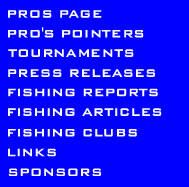
Click
here for Bruce Samson's Great New Instructionsal Interactive
DVD
|
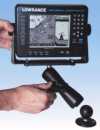
Ram 111-U The ultimate Electronics mount
Click
here for more info
or to order |

Beautiful Musky and Outdoor
Prints! |
|
Fishing articles from Walleyes Inc
|
Details rule the day for panfish |
In the evening, as the sun drops near the tops of the trees, the web of life comes alive and panfish rise to actively feed on zooplankton and other food sources. During this brief period, as long as you’re in the right place, you can cash in with less-than-stellar presentations. But what about the rest of the day? What about most of the day?
During the daylight hours, most ice anglers struggle to catch much of anything.
It doesn’t have to be that way. It isn’t that way for Dave Genz, because he has a system, the Winter Fishing System, that produces consistent catches of nice bluegills, crappies, and perch in the middle of the day.
It’s all about understanding what’s going on down there. That, and attention to detail.
Understanding Midday
Generalizing gets you into trouble, but on most days on most waters, panfish species are driven by the desire to avoid being eaten by bigger predators such as walleyes, bass, and northern pike. “Panfish, you might say, are in hiding mode,” says Genz.
Dave talks about three primary daytime panfish hideouts:
* In the weeds.
* Depressions (deeper holes) in bays or on large flats.
* Suspended over open water, at a depth where they become hard for predators to see.
Daytime panfish are usually not active, but will ‘sample’ your bait, if it looks natural.
If you mainly pursue panfish, this is the time when you must remain on the move, drill lots of holes, and keep looking until you locate fish. This is also the time when attention to detail in presentation is critical.
Here are more details on what to look for in a daytime panfish spot.
* Weeds or other available cover.
If a lake has abundant weeds, and they grow down to about 8 feet or more, chances are many fish will use the weeds–especially at early and late ice. Best weeds are green, upright and healthy. In some iced-over lakes, some weeds actually grow if sunlight penetrates. But, even when weeds are brown and yucky, fish will still use them, especially if they remain upright. In the middle of the day, key on thick clumps of weeds close to outside edges.
* Depressions and other holes.
If you know that panfish typically inhabit a certain large bay, for example, and you can find a couple places where it dips even a few feet deeper, those “depressions” as Genz calls them, can be key daytime spots.
Some of today’s ultra detailed contour maps will show you these depressions and holes. If the detailed map can be displayed on a GPS unit, you can go right to the spot and start drilling holes. Even cruder contour maps will often show the rough outline of such depressions.
* Deeper water.
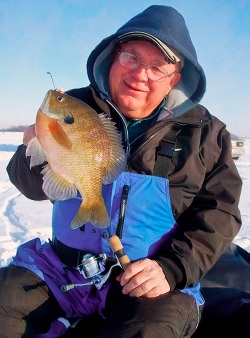
Daytime ice fishing is all about details, the willingness to move and drill holes and catch a few nice fish before moving again. Here, Dave Genz holds up a bluegill anybody would be thrilled to catch, taken under the glare of the midday sun |
Many panfish use the relative security of water depth to hide from predators during bright daylight hours. The fish simply hold in a depth “where they’re hard to see,” notes Genz, who has long suspected this dynamic. If a lake does not have much in the way of weeds or other shallow-water cover, panfish will use ‘the cover of relative darkness’ in this way to escape predators.
* Specifically, sticky-bottom areas.
It was Genz who got onto the magic of what he called sticky-bottom areas.
In places where the bottom composition is neither rock hard nor ‘too mushy,’ burrowing insects make their home. In the days before the Vexilar, “we used to use those lead weight depthfinders you clamp on your hook,” remembers Genz, “to find the bottom and set your bobber. I noticed that in a lot of places where we caught big panfish, when you dropped that weight to the bottom it would stick when you tried to pull it out. Your rod tip bent, and you had to pull to get it free.” |
Sticky-bottom areas in middle depths have bonanza potential. “That’s the frontier in ice fishing,” says Genz. “When you find those fish, they’re often the biggest ones in the lake, and they’re usually not pressured. You can have those spots to yourself.”
(Lindy makes Techni-Glo and Go-Fer-It clip-on weight depthfinders, that let you manually probe for the rod-tugging resistance of sticky bottoms.)
Daytime Efficiency
As an ice angler, you have to face the fact that you cannot troll or drift, or make long casts, in order to ‘check’ large areas. That’s why Genz always talks about efficiency, and mobility, especially when it comes to daytime fishing.
Here’s what efficiency in ice fishing means:
* Being set up for mobility, and in the mood to move as often as necessary.
This means wearing ice-specific clothing, like Ice Armor suits, so you can kneel on the ice and fish numerous holes quickly. It means packing only what you need into the sled of your Fish Trap, so it’s as light as possible. It means using a vehicle, ATV or snowmobile to make “big moves” from one lake to the next, or one general section of a lake to another. (Or, being willing to walk long distances if that’s what it takes to find fish.)
This is the ‘horizontal’ aspect of efficiency, meaning you move as far and often as necessary to try new spots until one of them pans out. This aspect also includes being able to drill holes almost effortlessly, “which is now possible,” says Dave, “with the new (Strikemaster) augers we all use.”
* Getting up and down quickly, even in deep water.
This is the ‘vertical’ part of efficiency. Genz is partial to jigs and other lures that “fish heavy for their size,” so he doesn’t have to wait long for the bait to descend into the fish zone. Genz helped design ice-specific baits for Lindy, and relies on them to keep him efficient. When he fishes, it’s a study in speed whenever the bait has to come up for a shot of the Tazer, or to check the bait. If he’s seeing fish 18 feet down over 22 feet of water, his bait drops like a rock until it gets to about 15 feet, then he slows down and fishes it into the ‘zone’ looking for a bite.
“No matter how deep or how dirty the water is,” he says, “I can see exactly what I’m doing on my Vexilar. You see the fish, you see your bait, and you see how the fish responds to the bait.”
If the fish does not respond right away, Genz experiments with presentation details. If the fish won’t bite after a few minutes, he goes looking for one that will.
First Drop Magic
Genz has forever said that big fish get big by being aggressive. That’s why he urges us to be completely ready as our bait sinks on the first drop down a new hole.
“If you’re going to catch a nice fish,” says Genz, “it usually happens right away. You put the bait down there and they come up and bite.”
So, in the Genz playbook, you…
* Pre-stretch the first 50 feet of line before you start fishing, so it hangs loose and straight. This gives you much more control and feel with light baits.
* Put on fresh bait, or make sure the plastic trailer is straight.
* Slide the knot around on the eyelet of the jig, if it’s a horizontal bait, and make sure it hangs horizontally before you put it down there.
* Concentrate as the bait is sinking on that first drop down a new hole.
“Be happy,” says Genz, “when you catch a nice fish. But don’t fall in love with that hole.” While you can sometimes catch more nice fish out of the same hole in the middle of the day, that’s the exception. If you don’t catch another within about five minutes, move.
Remember that details rule the day. All the little things need to be working in your favor, so you can piece together a good catch a few fish at a time. That’s what daytime ice fishing is, piecing together a good catch one at a time, with lots of moving and hole drilling between bites.
Note: Dave Genz, known as Mr. Ice Fishing, was the primary driver of the modern ice fishing revolution. He has been enshrined in the National Fresh Water Fishing Hall of Fame and Minnesota Fishing Hall of Fame for his contributions to the sport. For more fishing tips, go to www.davegenz.com.
|
|
Please
Check Out these links below to our site Sponsors |
|
|
|
|
|
|
|
|
|
|
|
|
|
|
|
|
|
|
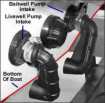
Survivor Livewell Intake System on "The
Run"
Click
Here For
More Information
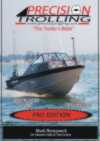
New Precision Trolling Pro Edition With Plastic Pages and
Easily Updateable click
here for more information
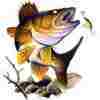
Check
out our T-shirt Line Now in colors and long sleeves
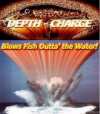
Church Tackles Walleye Planer Board

Click
here for more info or to order on-line
 Walleyes
Inc. Pro Team Team Favorites Lodging,
food,tackle, equipment and more Walleyes
Inc. Pro Team Team Favorites Lodging,
food,tackle, equipment and more
|

